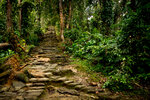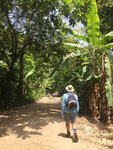

With dry socks and boots back on after wading the chilly water of the Rio Buritaca, we found ourselves standing before ancient steps that rise steeply up into the rainforest. Step by step over the smooth stones, we made our way upward.
After about 45 minutes of climbing, we broke out of the vegetation and stood blinking in the bright tropical sunlight. We were standing on a flat, circular stone terrace far above the river, with spectacular views up and down the valley. A jumble of terraces of different sizes buttressed by massive stone ramparts climbed the ridge above us.
The whole effect was exhilarating and humbling.
We had reached the destination of our hike — La Ciudad Perdida, the Lost City of Teyuna, a pre-Columbian site dating back perhaps 2,000 years that had been lost to modern memory until being discovered by grave robbers in the 1970s.
After spending the morning exploring the mysterious emerald green ruins and learning about their story from our guides, we returned to the lodge to pack up and hike back down the valley.
The three-night trek on the lower slopes of the towering Sierra Nevada was the highlight of our visit to the area around the seaside city of Santa Marta, Colombia.
Dream destination
From the coasts of two oceans, to the high peaks of the Andes, to the jungles of the Amazon basin, Colombia offers many treasures for the adventure traveler, and its natural beauty and biodiversity present endless opportunities for amazement.
Colombians are consistently rated among the world’s happiest people. This certainly applies to my wife and her wonderful family. They are warm, friendly and gracious to a fault.
We have traveled several times to Liliana’s home country from our home in Gray’s Creek, but the trip to the area around Santa Marta stands out for its breadth of memorable experiences.
On the trail
In total, we endured four grueling days of steep trails, tropical heat, biting insects and tired feet. But the experience was well worth it. The other particulars of the tour — the ride to the trailhead, prepared meals, comfortable beds, showers, swimming in the river, and, especially, the patience and forbearance of our guides — more than canceled out the rougher parts.
Starting about 20 years ago, the local and national governments in Colombia, along with the communities of the area, implemented a plan to promote ecotourism. Today, organized cooperatives offer package tours that include accommodations, food, transportation and guides. The indigenous families of the area are actively involved in the program, opening their houses to host and cook for passing travelers. Their efforts serve as a model for sustainable ecotourism, and it felt good to be a part of the whole enterprise.
You can pay extra for a mule to carry your pack. Personally, I had enough to deal with just putting one foot in front of the other on some of the steeper stretches, and there’s no way I could have made the hike with anything heavier than a daypack.
Even though we were the lightest, we were also, shall we say, the most seasoned of the hikers in the group, such that we (OK, me) were usually bringing up the rear.
In hindsight, I probably should have done a bit more physical conditioning. But in fact, there is very little to do to prepare oneself for hours of hoofing it up and down the steep, sustained and muddy inclines of the jungle trail to Teyuna.
The first day of the tour, we met our party of about a dozen just off the coastal highway and clambered into 4-wheel-drive trucks to make our way up the mountain. Our group was a lively bunch of younger backpacker-types, mostly Spanish and French but also Germans, Dutch and a Belgian.
Piling out of the trucks at a small village about 500 feet up the mountain, we readied to bid civilization goodbye.
Machete Pelao, which literally means “unsheathed machete,” saw boom years during the so-called bonanza marimbero in the 1970s and ’80s, when small farmers moved into the hills to cultivate marijuana for the American market and dollars flowed into the region. None of the town’s rough past is evident today, replaced by the tranquility and stability of the tourist trade.
After lunch, we strolled the streets and entered the countryside. In short time, the trail turned steeply upslope and our physical challenge began in earnest.
At our first rest stop, the guides pointed out a rough line in the vegetation where the forest began. Below was more or less open land. The line marked the area where many years ago illicit crops had been sprayed with herbicide in eradication efforts by the government.
The trail meandered up the valley, climbing through open country and into the forest, across ridges, then back down to the river at the foot of the ruins.
Accommodations were simple but felt like luxury at the end of a long day of hiking: a cold shower and a bunk for your bedroll. The food was fantastic, and there was always plenty of cold beer and soft drinks.
Four days later, our group was back in Machete Pelao, tired but celebratory.
Getting there
We flew to Miami, then on to Bogota, Colombia, to reach Santa Marta.
Landing at the spiffy, clean Simón Bolívar International Airport, we took a taxi to our lodgings. Along the way, the taxi driver took us on a quick tour of the city and a side excursion down a rugged gravel road to the beach at Bahia Concha, where we took our first dip in the Caribbean Sea.
Rising from sea level to a height of 18,700 feet in just 26 miles, the Sierra Nevada de Santa Marta are the second tallest coastal mountains in the world. Situated at the far northern tip of South America, the massive snow-capped peaks stand alone, separated from the Andes range to the south by broad plains. Fed by glaciers at the highest elevations, dozens of rivers flow down the mountains, supplying water to a vast region.
The Sierra Nevada are home to indigenous peoples whose ancestors were some of the first to encounter Spanish colonization and who today are among the few to have successfully resisted subjugation and assimilation. The mountains served as the cradle of the Tayrona civilization, whose people built the Lost City of Teyuna and buried their dead there in upright tombs filled with gold offerings.
The trail passes close by settlements of the Wiwa, a deeply spiritual people who live simply at one with nature and consider every living and breathing aspect of their world sacred.
Caribbean coast
As the mountains topple into the Caribbean, they form a series of dry rocky headlands, turquoise bays and pristine beaches within Tayrona National Natural Park. The protected preserve of lagoons, reefs, boulders and jungle is rich in biodiversity and an ecotourist’s dream destination.
Visitors can take a boat tour, birdwatch, hike, ride a horse, enjoy fresh-caught seafood, snorkel along coral reefs, swim in the clear blue sea or just relax on the beach.
We stayed at the delightful Eco Hostal Yuluka near the entrance to the park, where one morning at breakfast we watched as a large green lizard climbed out on a limb above us and feasted on a nest of eggs.
A number of other comfortable and clean eco-hostels and lodges are located nearby, with frequent taxis and buses available to bring visitors to the entrance.
City by the bay
Santa Marta, the oldest Spanish settlement in Colombia and the second-oldest in South America, is a modern city with gleaming white apartments and a crowded marina at one end of the harbor and busy shipping docks at the other.
The blazing tropical heat of midday calls for lounging by the pool or catching the breeze from a shady rooftop terrace. We enjoyed both at the Hotel Boutique Casa Carolina, as well as luxuriant architecture, great service, a spotless room and a restaurant featuring delicious local fare. The hotel is among several such hidden gems tucked off the street in the colonial city center.
A late afternoon walk along the waterfront offers the opportunity to dip your toes in the Caribbean and catch a glimpse of how the locals live.
With a lively night life of shops and restaurants full of tourists and locals, the colonial streets and plazas of the old town are perfect for an evening stroll.
Perhaps the city’s top tourist attraction is the Quinta de San Pedro Alejandrino, a hacienda built in the 17th century that was the death place of the liberator Simón Bolívar on Dec. 17, 1830.
Other attractions near Santa Marta include El Rodadero, a high-rise beachfront town popular with well-to-do Colombians, and Taganga, a collection of scruffy streets by a deep-blue bay that is known as one of the best places in Colombia to learn scuba diving.
On the last day of our trip, we took a half-hour boat ride up a fast-flowing river to visit Taironaka. The small, quiet nature preserve and archaeological site is planted with a profusion of tropical flora, with peafowl wandering amid splashy bird-of-paradise plants. A small museum tells the story of the Tairona people with artifacts and artwork.
The centerpiece of the park is a series of familiar stone terraces that once served as the hub of a community, quiet reminders of a time long ago.